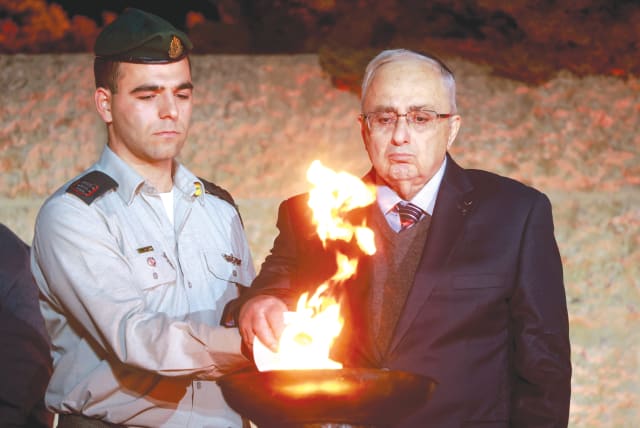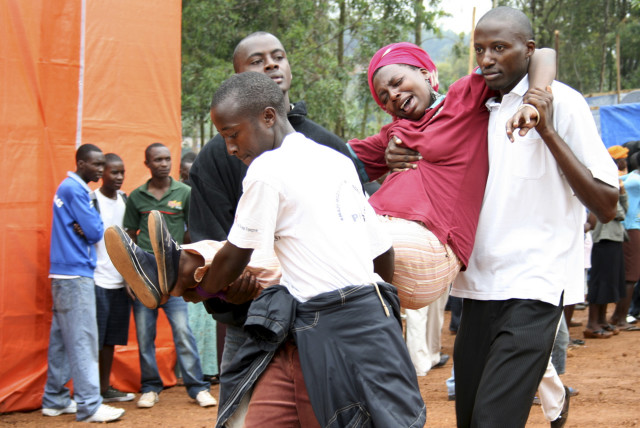Editor's Notes: Don't 'All Lives Matter' the Holocaust

The Holocaust was an event without parallel in human history and the Nazi drive to murder Jews was singular and obsessive.
One of my last trips abroad before the pandemic brought air travel to a halt in early 2020 was to Rwanda.
Organized by OLAM, a network of Jewish and Israeli humanitarian organizations, it was a study trip meant to familiarize participants – most of whom were executives with Jewish and Israeli nonprofit organizations – with the beautiful yet deeply scarred central African nation, and with the important role Jewish and Israeli aid groups, along with the Israeli government, are playing in the country.
One of the most shattering visits was to the Kigali Genocide Memorial, built atop the final resting place of some 250,000 victims of the 1994 genocide. The memorial has an interesting history. It was created by the Aegis Trust, a British organization founded by brothers James and Stephen Smith.
The Smith brothers, who aren’t Jewish, had been shaken by a 1991 visit to Yad Vashem and took it upon themselves to build Britain’s National Holocaust Centre and Museum in Laxton, a three-hour drive from London. As they were preparing for the Holocaust Centre’s opening in 1995, the brothers – along with the rest of the world – learned of the genocide taking place in Rwanda. Horrified, they took it upon themselves to commemorate this contemporary genocide, as well, and were eventually invited by Rwandan authorities to oversee the Kigali memorial’s formation.
Walking around the memorial, one is struck by the raw pain conveyed by the exhibits: human skulls in neat rows, walls of photographs of smiling victims, a window embedded in the ground to enable visitors to peer into a mass grave.
One is also struck by the striking prevalence of Jewish themes. The gently revised Talmudic quote, “He who saves a single life, saves the world entire,” appears on a glass panel in the center of the memorial. A room dedicated to other genocides around the world is dominated by a section on the Holocaust. Scattered throughout are references to Jewish texts and to the mass murder of Jews.
As I scanned the exhibits, I found myself troubled by a nagging thought: that someone had taken the prism of my people’s pain and imposed it on another nation, and that the Rwandan people were being denied an authentic experience of remembrance by having their trauma forced into a foreign framework of commemoration.
IT IS a basic human instinct to seek ways to connect events that appear, on the surface, to be similar to one another. But to do so when it comes to collective memory is to risk diminishing the uniqueness of each group’s experience.
In 2022, the White House issued a well-intentioned but poorly-worded statement about Holocaust remembrance that recalled “the six million Jews who were systematically and ruthlessly murdered by the Nazis and their collaborators,” as well as “the millions of Roma, Sinti, Slavs, disabled persons, LGBTQ+ individuals, and political dissidents who were killed during the Shoah.”
This past Tuesday night, after I tweeted about Yom Hashoah, a South African Twitter user with a timeline full of antisemitic tweets responded with a screenshot of the Wikipedia entry for “Holocaust victims.” On that page is a table that lists 12 different groups defined by the crowdsourced encyclopedia as victims of the Holocaust.
They include Soviet POWs (2.8-3.3 million), Freemasons (80,000-200,000), and Spanish Republicans (3,500), alongside Jews. Taken together, the 11 non-Jewish groups vastly outnumber the six million Jews noted on the page – which is, of course, exactly the point. My Twitter interlocutor’s message was clear: the Jews weren’t even the primary victims of the Holocaust, so they should really stop harping on about it.
This needs to be said: the Holocaust, the Shoah, was the mass murder of Jews. That the Nazis also murdered millions of other people – whom they viewed as racially inferior, sexually deviant, politically incompatible or simply undesirable – is a series of horrors of stunning magnitude that took place in parallel to, not as part of, the Holocaust.
The Holocaust was an event without parallel in human history and the Nazi drive to murder Jews was singular and obsessive. The entirety of the Nazi state was dedicated to the erasure of the Jewish people from the face of the earth. The German nation – a highly advanced society at the pinnacle of cultural, scientific and intellectual achievement – was fed a steady diet of poisonous propaganda meant to dehumanize Jews and condition their non-Jewish neighbors to support, facilitate and participate in their murder.
The murder itself was mechanized and methodical, carried out on an industrial scale and with staggering precision. Even toward the end of the war, as supplies dwindled and German commanders clamored for materiel to enable them to make a last stand, Nazi leaders continued to dedicate enormous resources to rounding up, transporting and murdering as many Jews as they possibly could.
That combination of factors, coupled with the millennia of pervasive antisemitism that led to them, set the Holocaust apart from both concurrent atrocities perpetrated by the Nazis and other acts of mass murder that have taken place throughout history. There had been nothing like the Holocaust before it happened and there has been nothing like it since.
But the Jews are far from alone; every group that has experienced collective trauma is entitled to the uniqueness of its pain. The Armenian genocide, the Rwandan genocide, the Darfur genocide, the Yazidi genocide, and every other genocide in modern history has had its own unique characteristics and constitutes a unique source of pain for the people it sought to destroy. Similarly, every act of mass murder perpetrated by the Nazis against any of the groups they despised should be understood in its own unique context and remembered as such.
Each trauma deserves to be recognized and commemorated in its own right. Lumping them all into a single amorphous category and attempting to draw tortured parallels between them diminishes their singularity and denies the authenticity of survivors’ memories. It is the “all lives matter” of collective trauma, the painting of all experiences of collective pain with a single, coarse brush to erase the very real distinctions between them.
Which brings me back to Kigali.
As I walked out of the memorial and into the heavy afternoon air, I approached our guide – himself a survivor of the genocide – and gingerly asked what he made of the Jewish themes throughout the site and whether he could relate to them.
“Of course,” he said to me as we made our way to the bus. “You are our inspiration. We look at what happened to the Jews in Europe and what you went on to build in Israel and we see hope for what our future could look like.”
That survivors of different genocides and acts of mass murder can draw strength and hope from one another’s experiences is beautiful, and that people of goodwill like the Smith brothers can feel compelled by one act of memorialization to engage in another is inspiring.
Even as we seek to find kinship in our shared pain, however, we must take care to protect the uniqueness of each group’s collective trauma and respect the integrity of its collective memory.
Jerusalem Post Store
`; document.getElementById("linkPremium").innerHTML = cont; var divWithLink = document.getElementById("premium-link"); if (divWithLink !== null && divWithLink !== 'undefined') { divWithLink.style.border = "solid 1px #cb0f3e"; divWithLink.style.textAlign = "center"; divWithLink.style.marginBottom = "15px"; divWithLink.style.marginTop = "15px"; divWithLink.style.width = "100%"; divWithLink.style.backgroundColor = "#122952"; divWithLink.style.color = "#ffffff"; divWithLink.style.lineHeight = "1.5"; } } (function (v, i) { });

